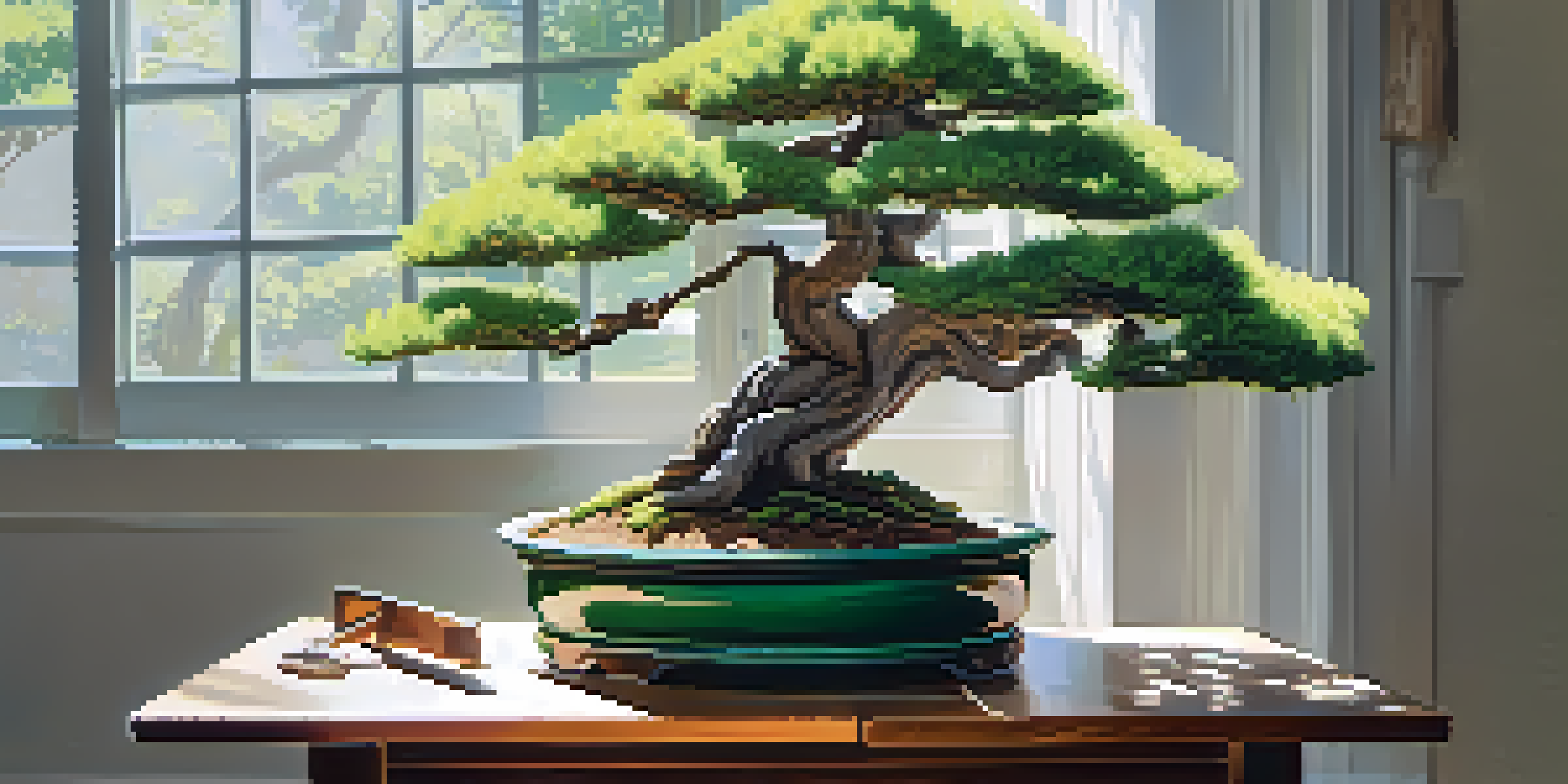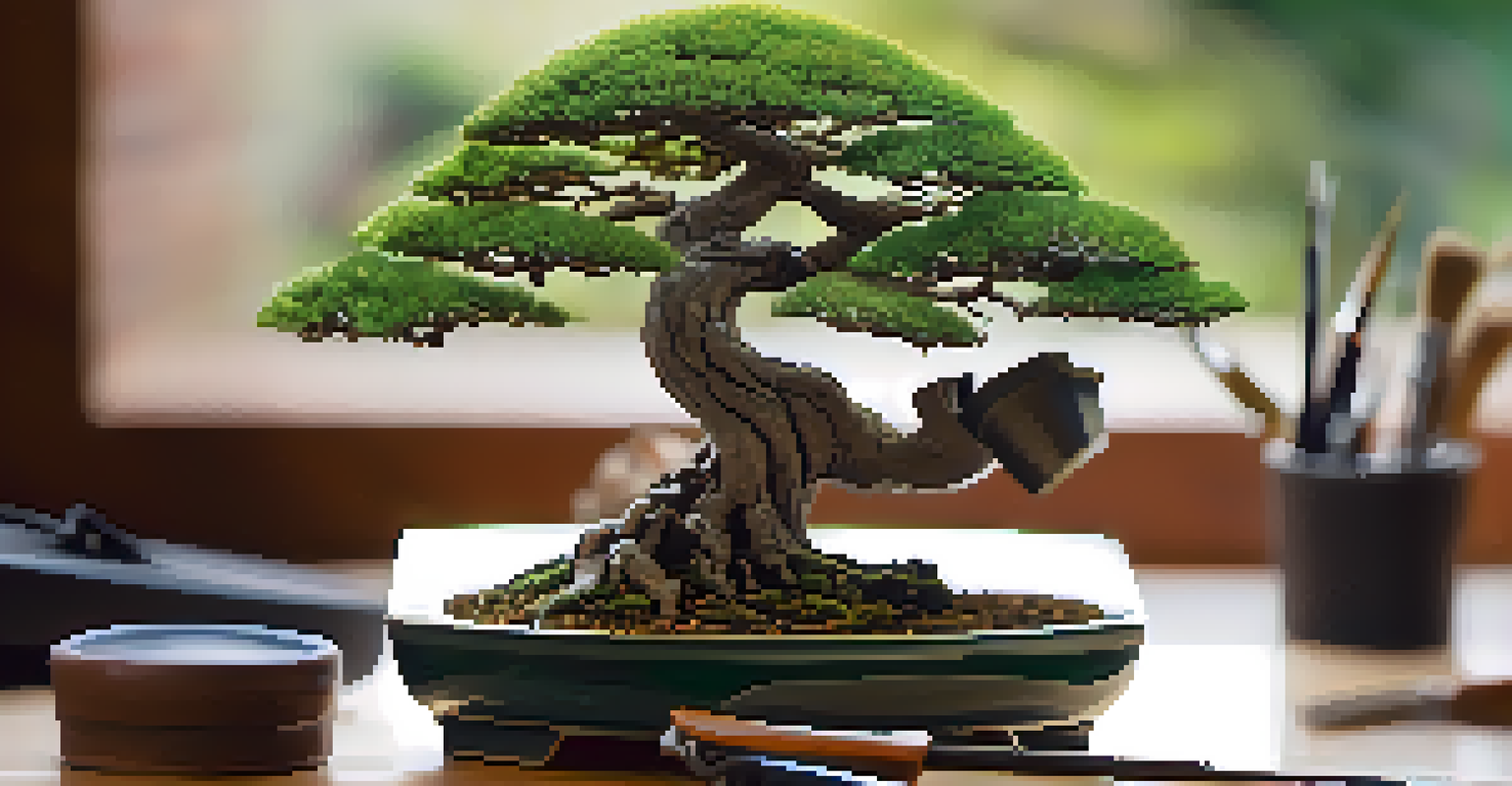Pruning Techniques for Shaping Your Bonsai Tree

Understanding the Importance of Pruning Bonsai Trees
Pruning is a crucial aspect of bonsai care that goes beyond aesthetics. It helps maintain the tree's health and encourages new growth, ensuring that your bonsai flourishes. Just like regular haircuts promote healthy hair growth, pruning keeps your bonsai tree vibrant and manageable.
The art of pruning is not just about cutting; it’s about shaping and guiding the tree to express its full potential.
When you prune, you're essentially communicating with your tree, guiding its shape and form. It's an art that requires patience and practice, allowing you to develop a unique style that reflects your personality. The right pruning techniques can transform an ordinary tree into a masterpiece.
Moreover, pruning helps prevent overcrowding of branches and leaves, which can lead to poor air circulation and disease. By regularly assessing your bonsai's growth, you can ensure it remains healthy and beautiful for years to come.
Essential Tools for Pruning Your Bonsai Tree
Before diving into the world of bonsai pruning, it's essential to have the right tools at your disposal. A good pair of bonsai shears is a must—they're designed specifically for clean cuts that minimize damage to the tree. Additionally, you might want to invest in wire cutters and concave cutters for more intricate work.

Using the appropriate tools not only makes the process easier but also ensures that your cuts are precise. Clean cuts promote faster healing, reducing the risk of infection. Just like a chef needs sharp knives to create a culinary masterpiece, a bonsai artist requires quality tools for successful pruning.
Pruning Enhances Bonsai Health
Regular pruning not only maintains the aesthetic appeal of bonsai trees but also promotes their overall health and encourages new growth.
Don't forget to keep your tools sharp and clean; this not only prolongs their lifespan but also helps maintain the health of your bonsai. A little maintenance goes a long way in ensuring that your tools are always ready for your next pruning session.
Understanding Different Pruning Techniques
There are several pruning techniques that bonsai enthusiasts use to shape their trees. One popular method is called 'pinching,' which involves removing new growth tips to encourage branching. This technique is particularly effective for maintaining the desired size and shape of your bonsai.
Pruning is a way of speaking to the tree, a dialogue that shapes its destiny.
Another technique, known as 'structural pruning,' is used to remove larger branches that disrupt the tree's overall balance. This method is vital for developing the tree’s framework and ensuring that it grows in harmony with its surroundings. Think of it as sculpting a statue—removing excess material to reveal the form underneath.
Lastly, 'maintenance pruning' is performed to keep the tree healthy and in shape throughout the growing season. Regularly trimming back growth ensures that your bonsai maintains its aesthetic appeal while encouraging robust health.
When is the Best Time to Prune Your Bonsai Tree?
Timing is everything when it comes to pruning bonsai trees. The best window for pruning typically occurs during the spring, just as new growth begins to emerge. This is when your tree is most active and can recover quickly from cuts.
However, the specific timing can vary depending on the type of bonsai tree you have. For instance, deciduous trees may require different timing than conifers. It's essential to research your particular species to understand its growth cycle and ideal pruning times.
Use Proper Tools for Pruning
Having the right tools, like bonsai shears and concave cutters, is essential for making clean cuts that minimize damage and promote healing.
Pruning during dormancy in late fall or winter can also be beneficial for certain trees, allowing you to shape them without stressing the plant. Just like planning a garden party, knowing when to prune ensures everything goes smoothly and your bonsai shines.
How to Approach Pruning with a Plan
Going into a pruning session with a clear plan can make all the difference. Before you start snipping away, take a moment to assess your bonsai's current shape and what you want to achieve. Visualizing the final outcome can help guide your cuts.
It’s also helpful to sketch your tree or take photographs to track its progress over time. This practice allows you to see how your pruning decisions affect growth and shape, providing valuable insights for future sessions. Think of it as a roadmap to your bonsai's transformation.
Remember, patience is key! Don’t feel pressured to make drastic changes all at once. Gradual adjustments allow your bonsai to adapt naturally, leading to a more harmonious end result.
Common Mistakes to Avoid When Pruning
Even seasoned bonsai artists can make mistakes when pruning. One common error is over-pruning, which can stress the tree and hinder its growth. It's essential to remember that less is often more—always aim for balance in your cuts.
Another mistake is not considering the tree's overall design and growth pattern. Pruning without a plan can lead to an unappealing shape, leaving your bonsai looking inconsistent. Take the time to understand your tree's natural growth habits to make informed decisions.
Timing is Key for Pruning
The best time to prune bonsai trees is during spring when they are most active, but timing can vary based on the specific species.
Lastly, neglecting proper care after pruning is a mistake many beginners make. After cutting, your bonsai may need extra attention, such as careful watering and protection from harsh sunlight. Just like after a workout, your bonsai needs a little TLC to recover!
Maintaining Your Bonsai After Pruning
After you've completed the pruning process, it's important to maintain your bonsai's health. This includes proper watering, as your tree may need a bit more hydration after losing some foliage. A well-hydrated tree is better equipped to heal and thrive.
You might also consider adding a fertilizer to promote new growth. However, be cautious not to over-fertilize, as this can lead to burning the roots. Think of it as giving your bonsai a nutritious meal—too much can do more harm than good.

Finally, keep a close eye on your tree over the next few weeks. Monitoring its health and growth will allow you to address any issues early on, ensuring your bonsai continues to flourish and thrive after your careful pruning efforts.